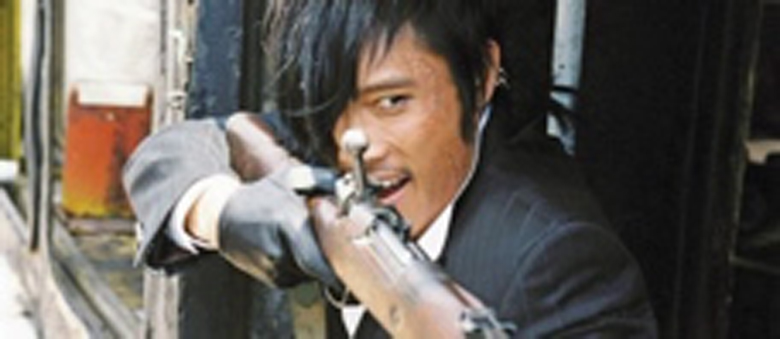Reviews
Joheunnom nabbeunnom isanghannom
Kim Ji-woon
South Korea, 2008
Credits
Review by Timothy Sun
Posted on 17 July 2009
Source 35mm print
Categories Favorites: The Action Movie
From The Great Train Robbery forward, the western has been one the main vehicles through which action cinema has woven its way into the American cultural fabric. The lure of the western is palpable: wide open vistas with which to stage stampedes, chases and charges; the pioneering ethos that necessitated men to be able bodied and heavily armed; the pervasive lawlessness that required those arms to be discharged with high frequency; ever-present conflicts pitting race against race, civilization against chaos, blue against grey; and most importantly, the perfect backdrop with which to create the myths that defined for Americans (and the world) a country of endless frontiers to be tamed and a rugged national character that was brashly independent and righteously violent.
The classical westerns of John Ford dealt increasingly with poking holes in this myth - his action scenes in The Searchers, for instance, are not merely cinematic exercises in manufacturing thrills, nor are they heroic or cathartic in any Here-comes-the-cavalry! sort of way. Instead, the action comes at a moral cost—to the characters, to the audience, to the genre itself. Cowboys versus Indians was no longer a simple battle of good against evil, it was instead revealed for what it was: the terrible, blood-soaked racism that made this country possible.
Much of the classical western canon uses the structure of the genre to deal specifically with notions of the American myth, either to support our idealized vision of ourselves or to undermine it (or at least question it). But by the time the spaghetti westerns of Sergio Leone came around, much of the introspection had been lost. For Leone, the western presented an almost purely cinematic space, rather than a national/historical one. He took the signifiers of our national myths - horses, guns, deserts, cowboys, outpost towns, shoot outs and standoffs - and divorced them from their sources, creating a cinema of almost complete iconography. The western became, in his hands, not a place for national mythology to be created or exorcised but a cinematic space in which to play with film form. Action is for the sake of action, morally suspect characters (even “heroes” like Clint Eastwood’s Man With No Name) never hesitate to the add to the (huge) body count and even the Civil War, in The Good, the Bad and the Ugly, is treated largely as a boy’s adventure.
It is somewhat ironic that Leone’s westerns have come to displace the classical Hollywood westerns in most people’s minds when it comes to defining the genre. Though perhaps it is fitting that their jaded, supranational (shot by an Italian director in Spain with an American star) and purely cinematic qualities endear them more to our modern, globalized world than Ford’s. They certainly hold more cache with filmmakers like Tarantino and Rodriguez, who have spent their careers openly idolizing the glorified B-movie attitude of Leone. So has South Korean director Kim Ji-woon. His The Good, the Bad, the Weird is the kimchi answer to Leone’s spaghetti westerns. The homage is largely titular, however—aside from the three main characters, a MacGuffin plot about finding treasure and a final three-way showdown, Kim’s film bares almost no resemblance to Leone’s.
But it is amazing how adaptable genres are. The uniting element between Kim’s and Leone’s films is their approach toward the genre. Each takes signifiers from the “western” and treats them not as intrinsically representational but iconographically, simultaneously reducing the genre to its signifiers and blowing it wide open by embracing and amplifying its most attractive, visceral elements. In taking this strategy to a cartoonish extreme, Kim extends Leone’s generic excesses to the breaking point, in a way completing the exercise Leone started. To view a classical western, a Leone western and then The Good, the Bad, the Weird is somewhat akin to playing an acid-spiked game of telephone, where the end result is almost unrecognizable but, somehow, you get the idea.
Their approaches to the genre are pretty much where the similarities between Kim and Leone end. For all of the gunfights and borderline sadistic violence Leone heaps on his films, the works are more notable for their patience and stillness than flying viscera. Leone loved long shots and he loved to draw out tension. When violence finally comes, it is extremely swift – bang, bang, bang and it’s done. Leone took his time, reveling in the framings of actors and setting, happy to light the fuse and watch it burn before the explosion comes. In The Good, the Bad and the Ugly, the central plot doesn’t even get under way until about 45 minutes into the film.
The Good, the Bad, the Weird barely lasts two minutes before gunshots erupt—and then never stop. From there, it’s a balls-out action flick, comprised of set piece after set piece, each topping the previous one in inventiveness and firepower. The bar is set extremely high right from the opening sequence, a spectacular locomotive heist that brings the three leads together and quickly establishes the tone for the rest of the film: blithe but graphic violence, comic book-style humor and utter disregard for realism. This is the kind of film where the only response to a given situation is to whip out a gun, where there is literally a town populated only by criminals, where a Mongolian tribe on horseback is brought on as comic relief (as if to reaffirm the plot’s incomprehensibility, the leader of the Mongolians, always a step behind the action, continuously asks his number two, “What’s going on here?”).
Whereas Leone’s films, though dubbed spaghetti westerns, belonged, really, to no national cinema, Kim’s film is decidedly Asian. For all of its spaghetti western trappings, the film is equal parts John Woo bullet-fest and martial arts film. The film relies less on the controlled standoffs abundantly found in westerns and more on the kind of massive, chaotic battles found in Hong Kong cinema, where pistols never run out of bullets and villains never run out of henchmen. The choreography of the action is truly something to behold, far more akin to martial arts films then westerns. Bodies are constantly in motion, leaping from horses to cars to motorbikes, across roofs and over staircases. In one of the most breathtaking sequences, the “Good” character, his long, Clint-inspired coat fluttering behind him like a cape, swings from a pulley as if in a wuxia film, firing his rifle into the combatants below. An ambush at an inn takes its cues directly from wuxia films, with characters swooping in and out of frame, attacking with bamboo staffs. Kim’s camera is as dynamic as his characters, effortlessly capturing the fluidity of the action; in one terrific shot, as the “Good” character jumps from one roof to another, the camera, which is in front of him, jumps backwards with him, catching the entire motion in one take. This is action filmmaking that reminds us movies are fun.
The characters are cutouts (though no more so than they are in Leone’s film) and the plot is riddled with holes, but the film speeds forward unawares, utterly confident in its sheer kinetic force. The wit of the filmmaking and the actors’ embrace of their ridiculous characters keeps the film from becoming a slog, despite the repetitive structure of the story. And then, just when you think you can’t take another shoot out, Kim gives you a jaw-dropping, reel-long chase across the desert featuring all three main characters, a gang of assassins, the Mongolian bandits, the Japanese Imperial Army and all manner of weaponry, from a mace to dynamite to artillery shells. Kim’s film is reportedly the most expensive South Korean film ever made, and believe me, every won is up on screen.
Like Leone, Kim sets his film in wartime, in Japanese-occupied Manchuria during World War II. And like Leone, the historicity of his setting is somewhat beside the point, aside from providing a general milieu of violence and disorder. It is impossible, though, for a Korean director to be as removed from the War of Resistance (as it’s still commonly referred to in Asia) as an Italian director can be from the American Civil War, and indeed, there is, perhaps, a bit of mythmaking in this kimchi western afterall. In the final chase across the desert, with the Japanese Army in hot pursuit, picking off Koreans and Chinese as they please, the “Good” character, instead of riding after the “Weird” who has the treasure map everyone is after, turns his horse and charges straight back at the Japanese, shotgun blazing. It’s a triumphant, even patriotic, moment in this most apolitical of blockbusters and, I imagine, a crowd-pleasing one in Korea. The treasure map, it turns out, leads to something that could change the outcome of the war, and it is, if not mythmaking, then at least revisionist wish-fulfillment that Kim has his three displaced Korean outlaws be the ones who keep the Japanese from getting to it, before riding off into the sunset.
More Favorites: The Action Movie
-

First Blood
1982 -
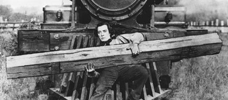
The General
1926 -
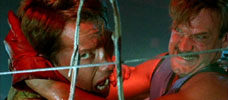
The Running Man
1987 -

Guns
1990 -

Highlander
1986 -
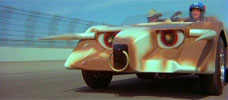
Death Race 2000
1975 -
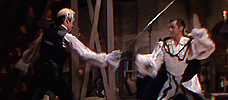
Scaramouche
1952 -

Do or Die
1991 -
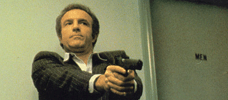
Thief
1981 -
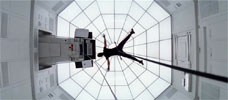
Mission: Impossible
1996 -
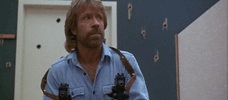
Invasion U.S.A.
1985 -

Rambo: First Blood Part II
1985 -

Bullitt
1968 -

Hard Hunted
1992 -
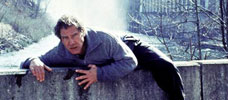
The Fugitive
1993 -
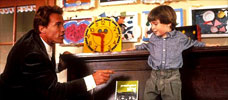
Kindergarten Cop
1990 -
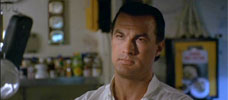
Under Siege
1992 -

Dirty Harry
1971 -
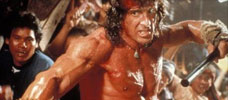
Rambo III
1988 -
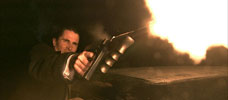
Public Enemies
2009 -
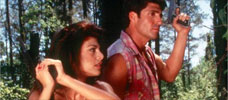
Day of the Warrior
1996 -

The Good, the Bad, the Weird
2008 -
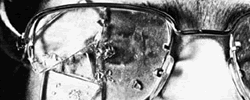
Straw Dogs
1971 -
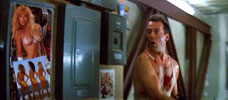
Die Hard
1988 -

Con Air
1997 -
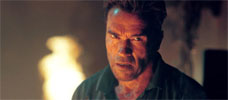
Collateral Damage
2002 -
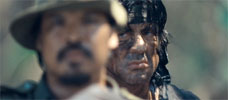
Rambo
2008
We don’t do comments anymore, but you may contact us here or find us on Twitter or Facebook.



